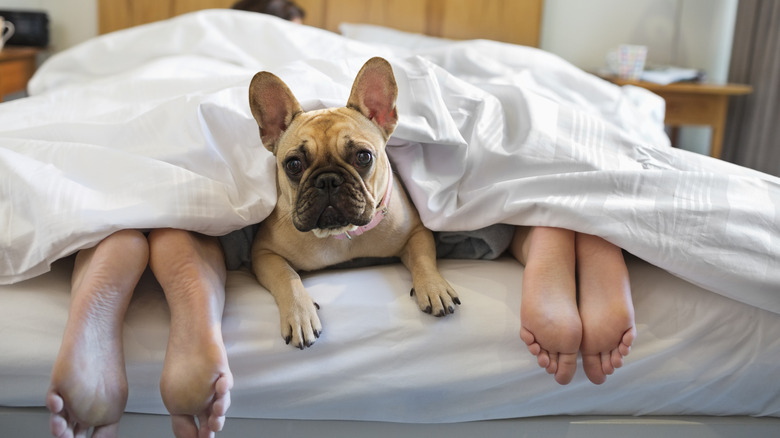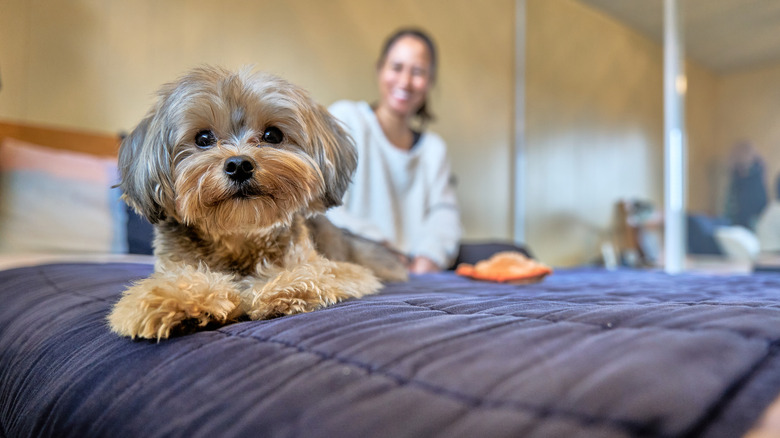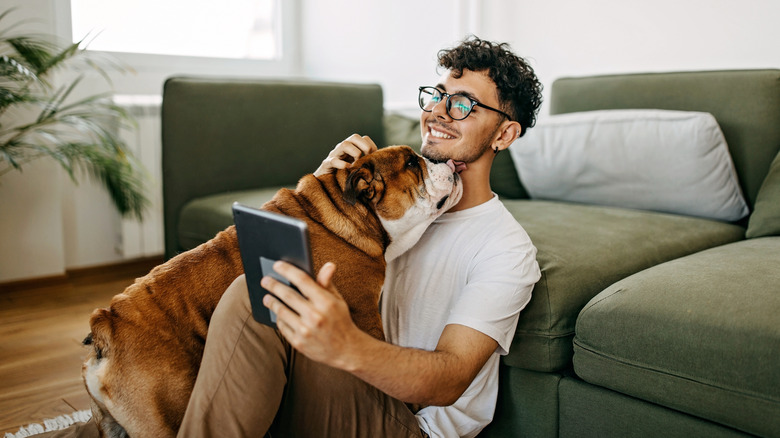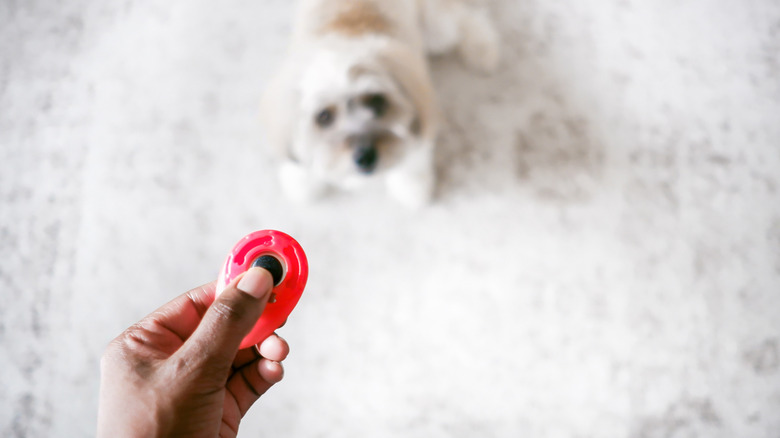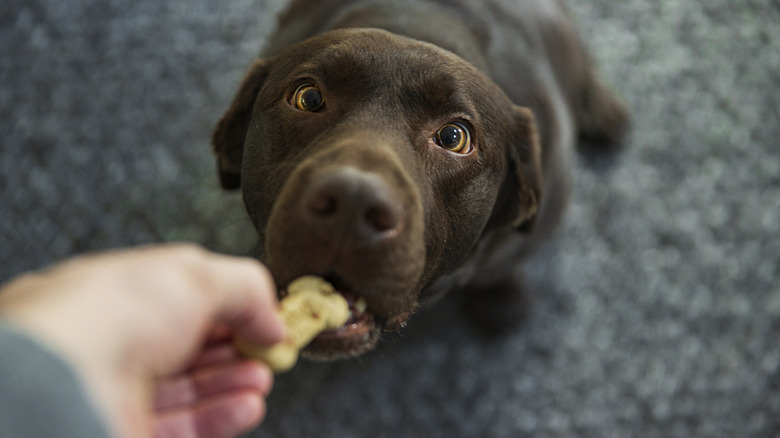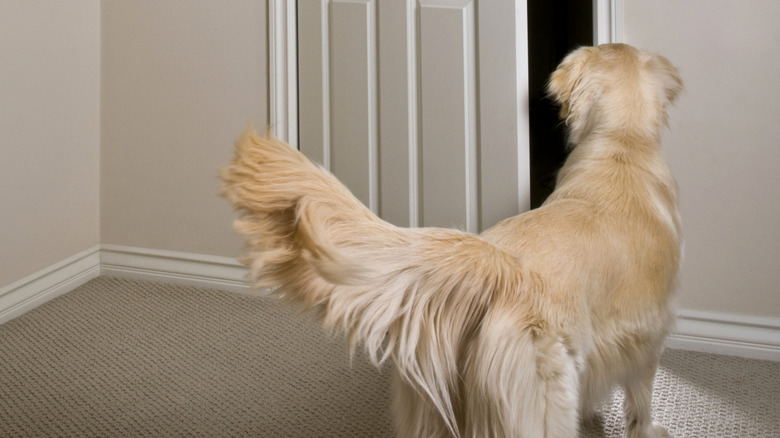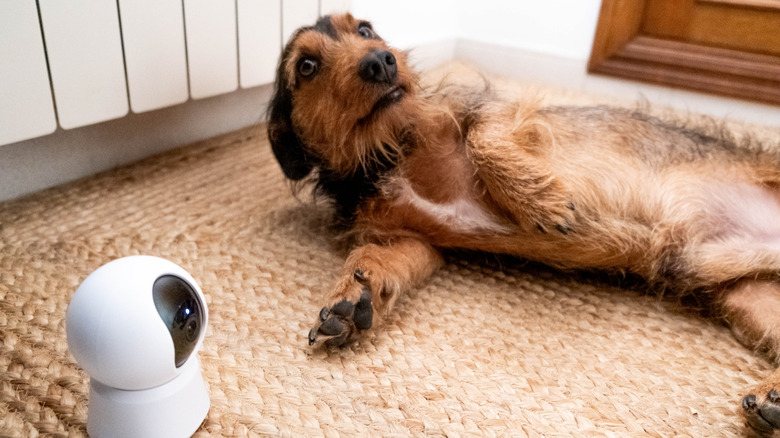How To Stop Your Dog From Sleeping In Your Bed
Who wouldn't want to cuddle with a dog in their bed? A lot of people, it turns out, and for a myriad of reasons: After all, these are the same creatures that, while beloved, also roll in poop and other stinky miscellany for fun. Even if they smell fine at the end of the day, they can still track dirt and debris onto your bed. It can also be a simple question of space: There might not be enough room for both a dog and humans in your bed, or maybe your dog moves around a lot at night and disturbs your sleep.
Then, there's the scenario where a human who likes letting their dog into bed meets another human who doesn't enjoy having a dog in bed. The two humans fall in love and, you guessed it, the dog often ends up getting voted off the (bed) island and relegated to the floor.
No matter your reasons for wanting to keep your dog out of bed, if it's already in the habit of snuggling with you at night, you're in for a battle of wills. However, you can tilt the battle odds in your favor by using a handful of tips and tricks to convince your dog that some other option is more comfortable, or simply more rewarding, than sleeping in your bed.
Teach your dog to stay off the bed when it's a puppy
Have you ever seen funny videos of people who let their tiny, cute puppy sit in their lap when it's small — only to end up with a much larger dog that keeps doing the same thing once it's grown? The same trajectory applies to puppies and beds: If you let your cute little puppy share your bed when it's small, it's going to think that is how life works and keep doing the same thing once it's bigger.
Make things easier on both of you by beginning the way you mean to continue: If you don't intend to let your dog sleep on the bed once it's grown, don't let it snooze there when it's a puppy, either. The odds are good that it won't even know what it's missing.
What if you adopt a dog that's already out of puppyhood? The same principle applies: Be firm and consistent in your rules from day one. It may take some time to get the message across, and if that dog is already used to sleeping in beds you may need to apply a few other tips and tricks to get them to stop. Everything starts with establishing the boundaries around your dog and your bed, then sticking to those boundaries — and getting everyone else in the house on board, too, so you aren't sending conflicting signals.
Give your dog its own bed so it won't want to sleep on yours
What if your dog is so fixated on sleeping on your bed that it just won't be deterred? It might need a bed of its own. In training, this is called substitution: If the problem isn't necessarily the behavior (in this case, sleeping) but the target of that behavior, give your dog a different target that you're okay with.
For example, every time your dog goes to the dog bed of its own free will, give it a treat. It won't take long for it to learn that going to bed — that is, its bed, not yours — is an opportunity to be rewarded. You can also give periodic treats for staying in its bed or, if that's too lofty of a goal right off, break the process down into smaller parts. Your dog looks at the bed? Treat. It approaches the bed? Treat. It puts one paw on the bed? Treat. You get the idea.
Of course, there's a catch: Every dog is different, and they can be picky about where they sleep. Maybe yours will prefer a heated dog bed, a memory foam dog bed, or even a quirky little sofa-style dog bed. The bottom line is to have a little patience, because it might take some trial and error for you to find the best dog bed that's more tempting than your own.
Teach your dog to hop on and off the bed on command
If you're grasping for control over your dog's bed-related behavior, try training it to hop on and off the bed on command. This accomplishes a couple of things. First, it gives you a way to get the dog off the bed when you want. Second, it teaches your dog that it has to wait for your command before getting on the bed, instead of just going for it whenever it wants.
The actual process of training your dog to get on and off the bed is fairly simple: If your dog is on the bed, give the command for getting off — perhaps something like "off" or "out" — and toss a lure, such as a treat or a toy, away from the bed. When your dog follows and takes the lure, it is collecting the reward for having gotten off the bed.
Similarly, if your dog happens to be off the bed already, sit on the bed and call it to join you. When the dog gets onto the bed, give it a treat or a toy as a reward. Consider laying a stash of treats or toys near the bed to use as rewards, too, so they're always handy the moment you want to reinforce your dog's obedience to get on or off.
Spend time with your dog outside of your bedroom
Any time you want to change one of your dog's behaviors, it helps to examine their motivation for that behavior. Are they trying to meet a need and, if so, can you provide some other solution to that need? In the case of hopping on the bed, it's quite possible that your dog is coming into bed because it misses you and craves your attention, or at least your closeness. Training a dog whose attention needs aren't quite being met can be a real challenge, because any kind of engagement when it's doing the undesired behavior — even yelling or anger — can be seen as a reward. At the end of the day, it's still attention.
If that's the case, you might be able to help meet that need by giving your dog more attention during the day. If you haven't already, block out time for playtime and interaction. That can be something as simple as going for walks or throwing a ball in the backyard. It can also mean working with your dog on obedience skills or tricks, or involving it in dog-specific activities like flyball that encourage togetherness while also letting it burn off a lot of energy. At the end of the day, togetherness and activity almost always lead to a happier, more relaxed dog, which then might not be so clingy once bedtime rolls around.
Consider clicker training
There's one fatal flaw in training your dog within the bedroom environment: Effective training means having treats or toys on hand for immediate reward, but you might not want treat crumbs or slobbery dog toys in your bed.
If that sounds like a familiar dilemma, consider clicker training your dog. The clicker gives you a little extra time by signaling to your dog that it has done the right thing, so you have a chance to get up and grab a treat or toy that's stashed a little further from your bed. You can even make your own dog clicker. It takes a little work to prep your dog for this style of training, but even beginners can start clicker training with the simple step of "charging," or priming, the clicker, or teaching your dog to associate it with a reward.
All that really means is spending some time with your dog during normal, everyday activities, randomly clicking the clicker, and then immediately tossing your dog a treat. When priming, it's important that you vary what your dog is doing. If you consistently click and treat when your dog is doing a particular behavior, it might learn to associate the behavior with the clicker. With that said, it's well worth the effort to start clicker training, because once you're under way, you will be free of doggie treat crumbs and slobbery toys in your bed.
Reward your dog when it stays off the bed
It might be tempting to yell at your dog when it hops onto the bed. That training tactic — somewhat confusingly known as positive punishment — might seem effective in the moment as it jolts your dog into jumping off the bed and maybe even expressing some contrition. However, your dog processes interactions through a different framework of reasoning than you do so, even if your dog understands that you're displeased, it may take the simple act of engagement and attention — even attention comes in the form of yelling — as a reward.
That is just one of many reasons why you should use positive reinforcement, like giving your dog a reward such as a treat, praise, or time with a toy whenever it does what you want by either getting off or staying off the bed. Positive reinforcement helps build trust with your dog instead of making it scared of you and, at the end of the day, positive reinforcement has been shown to be much more effective for improving learning, deterring unwanted behaviors, and even improving your dog's overall quality of life.
Hire a ringer to model good bed manners for your dog
It's not a myth that some dogs are easier to train than others. If you've been diligently trying your best human-to-canine training methods and getting nowhere, it might be time to hire a ringer. A dog ringer, that is. Just as puppies will naturally mimic and follow the behaviors of older dogs, your naughty bed-jumping dog might take a hint from another dog's good behavior.
Of course, it never hurts to invoke a little selfish motivation. Don't just use the well-mannered dog to demonstrate getting, and staying, off the bed. You can also use it for demonstrations that good behavior is rewarded. Or, to put it another way, let the naughty dog see you giving the good dog a reward any time it hops off the bed on command, or goes to its own bed on command — whatever behavior it is that you're trying to reinforce. Some dogs really are motivated by jealousy, and sometimes that, combined with a positive role model, is enough to get your dog to engage with the training process.
Crate train your dog to keep it off the bed
Crate training is one of the simplest ways of keeping your dog off the bed, but the principle runs a lot deeper than that: Your dog is instinctually a denning animal, and crate training a puppy or even a fully grown dog gives it the sense of having a den — a safe, calm place where it can relax during the day or go to bed at night. Once your dog is comfortable in its crate, it may not feel the need to be in your bed.
Make your dog's crate more effective by turning it into a comfortable, dog-friendly space. Start by making sure the crate is the right size; it should be big enough for your dog to comfortably sit, stand, and turn around, but not have a lot of extra empty space. Add in a comfortable blanket or dog bed for it to lay on, and consider adding favorite toys to help keep your dog engaged with something other than being on the bed. Finally, some dogs benefit from having their crate covered; others are more comfortable without a crate cover.
Close the door to keep your dog off the bed
Simply shutting your dog out of the bedroom is the simplest way of keeping it off the bed. However, there are many reasons why this might not be the ideal solution — not least because some dogs that are absolutely determined to get into bed with you might chew through that door, or at least scratch, whine, and bark at it. For those dogs, you ultimately still need to identify and address the root cause of why they're so desperate to join you in bed.
If you're okay with sleeping with your door closed and the dog respects the door as a barrier, maybe that simple solution is enough. Make sure you create a comfortable place for it to rest on the other side of the door, whether that's a dog bed or a crate, and then rest easy.
For other dogs, closing them out might simply be a temporary stopgap to help ensure consistency — for example, keeping them off the bed until they've mastered the trick of hopping on and off the bed only on command. Or, you might close the door only while you're gone, to keep the dog from hopping on your bed while you're away.
Ask a professional trainer for help
Training your dog would be so much simpler if you could just sit it down and explain why you want it to stop hopping up on the bed. Yet, it doesn't work that way, even with the smartest of dogs, and if you happen to have a particularly stubborn or high-energy dog, it may be even harder to train than usual.
Fortunately, you don't have to go into the struggle on your own: This is exactly the sort of situation where you should consider hiring a professional dog behaviorist or trainer to help you decipher what drives your dog to get onto the bed in the first place, then shape that behavior into something you're more comfortable with.
Some dog owners seem reluctant to hire a professional trainer, perhaps because they feel that indicates their dog is bad, or maybe that the owner themselves is failing somehow. It might help to consider the trainer as if they are a professional coach who will help you identify the blind spots that are keeping you from communicating what you want to your dog — or, alternatively, the moments in which you didn't even realize you were accidentally reinforcing the wrong behavior. Bringing in a trainer does not mean you and your dog are failing; it just means you're making use of a resource that is available to help you succeed.
Employ remote technology to keep your dog off the bed
Who knows what your dog does while you're out of the house? Only it does — unless you bring in some technology to help you play detective. Consider installing a pet camera that lets you keep an eye on your dog while you're out. This can be especially helpful if you're battling to keep the dog off the bed for sanity or health reasons. Of course, you should disclose the presence of the camera to any other humans who might find themselves in that room.
Some of the best pet cameras go a step further than just letting you see and hear your dog: They may have an audio feature that lets you speak to your dog — perhaps giving it commands to get off the bed or praising it for having done so — and a few pet cameras can even dispense treats for your pet upon your command. At the end of the day, the camera is just another tool to maintain consistency, although who knows, you might be surprised by what else you see your dog doing during the day.
Whatever approach you take, stay consistent
Going back to the idea of consistency: Once you have a plan for keeping your dog off the bed, it's vital that you stick to it — and give it some time to work. Dogs absolutely can and will learn different behaviors under the right circumstances but, much like toddlers, some dogs may test your boundaries to see if you're really going to enforce the rules — or they might simply need a little time to understand what it is you're asking of them.
That consistency can be a real challenge if you're in a multi-person household. Do your best to make sure the whole family is on board for whatever plan you've concocted to keep your dog out of bed, whether it's crating the dog at night, closing doors, or practicing hopping on and off the bed on command. Remember that at the end of the day, you have only a limited ability to control the other people in your household. Your dog is smart enough to differentiate between the different household members' tolerances so, as long as you're consistent in your boundaries, the dog will at least learn to stay out of your bed — even if it might continue pushing the boundaries with other family members who are not as firm.
